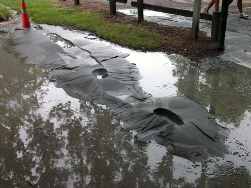
The aftermath
The latest official figures (May 2011) reveal that there were 181 confirmed fatalities - 0.05% of the city’s population - and over 7000 injuries as a result of the February 'quake. A month after the international media teams had left the scene, the country was still in a National State of Emergency, giving the authorities the power to 'lock down' New Zealand’s second largest city.
I visited the city three weeks after the 'quake to study the effects as part of the UK Earthquake Engineering Field Investigation Team (EEFIT). I joined one of the damage assessment teams, composed largely of volunteer engineers working tirelessly to ascertain the full extent of the damage. When I arrived, the entire city centre was encircled by fences manned by military patrols (for public safety and security). The streets were deserted and eerily quiet. The amount of damage is visually very obvious, with intensities reaching 9 on the Modified Mercalli intensity scale: un-reinforced masonry buildings crumbled under the strong shaking and many of the city’s historic buildings, including the tower of its famous cathedral, are now sorry piles of rubble. Extensive liquefaction of alluvial sediments has left a layer of fine sand on the streets, burying cars up to their doors. Post 1980s buildings were damaged, their columns shot through with X-shaped shear cracks, while several tower blocks have acquired a slightly uncomfortable lean. The streets are literally divided, having been torn apart by lateral spreading even on flat ground, but particularly along sloping ground on the banks of the Avon River.
Why so strong?
Several geological factors combined to make the M6.3 Christchurch Earthquake so much more destructive than the M7.1 Darfield Earthquake. Obvious reasons are that the epicentre was much closer to the city centre, the focus was also much shallower and the 'quake struck at 12:51pm when people were up and about. Even so, for a M6.3 earthquake the experienced ground-shaking in the city's Central Business District (CBD) was unusually strong, with vertical ground accelerations well in excess of 1g (1.42g) measured by GeoNet’s strong motion network – that is equivalent to the force required to lift 180 cups of tea! So what else was going on?
Hidden faults
As the damage inspection team entered an old building to make an internal inspection, our team leader, a Christchurch-born structural engineer, reminded me that “Christchurch is not meant to get big earthquakes, so this has come as a real shock to all of us”. In fact, in June 1869, a shallow earthquake of up to M5.8 was recorded under Christchurch, which caused damage to chimneys and masonry, and another possible M5.8 earthquake in 1870 occurred under nearby Lake Ellesmere. However, the fault segment that ruptured on 22 February 2011 was previously unknown to geologists. Russ van Dissen, geologist with the New Zealand Institute of Geological and Nuclear Sciences (IGNS), explained that the fault produced no surface rupture because it terminates 1km below the ground surface (a so-called ‘blind fault’). The national seismometer network deployed by GeoNet reported that it is an unusually steep reverse fault, orientated east-west with a southerly dip of 65 degrees. John Berrill, a Canterbury earthquake engineer who invented and installed the instruments that recorded the 'quake, suggested that the rupture started at 5km depth and then 'unzipped' upwards, generating multiple seismic waves aimed directly at the city.
‘Trampoline Effect’
Another contributing factor may be a phenomenon that IGNS seismologists call the ‘trampoline effect’, whereby soft, near-surface layers separate from stiffer underlying layers because they accelerate downwards faster. This results in a collision of layers, which generates additional energy. This effect may have contributed to stronger shaking and fueled the prolonged liquefaction.
The felt intensity generally diminishes with increasing distance from the earthquake epicentre but is also influenced by local soil conditions and topography. Christchurch sits on the edge of the Canterbury Basin, which is filled by up to 1500m of Quaternary alluvial and glaciofluvial sands and gravels, supplied by massive braided rivers that drain the eastern side of the Southern Alps. The upper 30m of sediment includes Holocene river alluvium, swamp peat, sand dunes and estuarine flats deposited during post-glacial sea level rise and recent river flooding. The soft/loose sediments under the city may have amplified the earthquake motions and caused them to liquefy. The lateral spreading of river banks caused many rivers channels to close-up and river beds to heave, leaving the many already low-lying areas now even more susceptible to flooding.